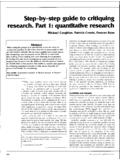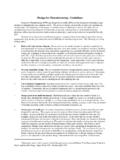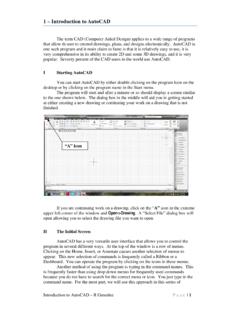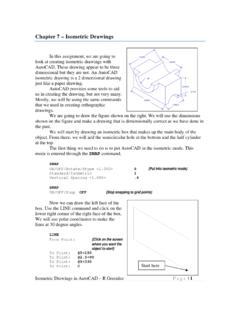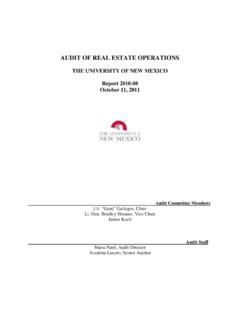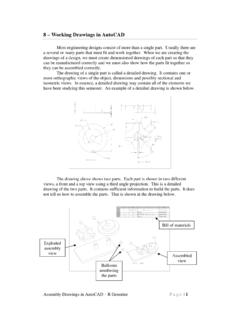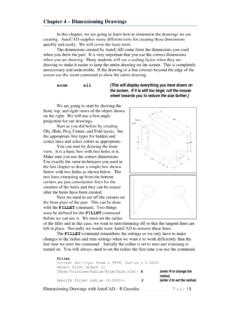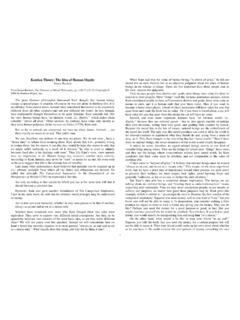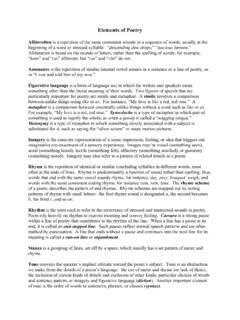Transcription of Elements of Fiction - University of New Mexico
1 Elements of Fiction Characterization is a means by which writers present and reveal characters by direct description, by showing the character in action, or by the presentation of other characters who help to define each other. Characters in Fiction can be conveniently classified as major and minor, static and dynamic. A major character is an important figure at the center of the story s action or theme. The major character is sometimes called a protagonist whose conflict with an antagonist may spark the story s conflict. Supporting the major character are one or more secondary or minor characters whose function is partly to illuminate the major characters.
2 Minor characters are often static or unchanging: they remain the same from the beginning of a work to the end. Dynamic characters, on the other hand, exhibit some kind of change of attitude, purpose, behavior, as the story progresses. Irony is not so much an element of Fiction as a pervasive quality in it. It may appear in Fiction in three ways: in a work s language, in its incidents, or in its point of view. But in whatever form it emerges, irony always involves a contrast or discrepancy between one thing and another. The contrast may be between what is said and what is meant (verbal irony), what is expected to happen and what actually happens (situational irony) or between what a character believes or says and what the reader understands to be true (dramatic irony).
3 Plot, the action element in Fiction , is the arrangement of events that make up a story. Many fictional plots turn on a conflict, or struggle between opposing forces, that is usually resolved by the end of the story. Typical fictional plots begin with an exposition, that provides background information needed to make sense of the action, describes the setting, and introduces the major characters; these plots develop a series of complications or intensifications of the conflict that lead to a crisis or moment of great tension. The conflict may reach a climax or turning point, a moment of greatest tension that fixes the outcome; then, the action falls off as the plot s complications are sorted out and resolved (the resolution or d nouement).
4 Be aware, however, that much of twentieth-century Fiction does not exhibit such strict formality of design. Point of view refers to who tells the story and how it is told. The possible ways of telling a story are many, and more than one point of view can be worked into a single story. However, the various points of view that storytellers draw upon can be grouped into two broad categories: Third-Person Narrator (uses pronouns he, she, or they): 1. Omniscient: The narrator is all-knowing and takes the reader inside the characters thoughts, feelings, and motives, as well as shows what the characters say and do.
5 2. Limited omniscient: The narrator takes the reader inside one (or at most very few characters) but neither the reader nor the character(s) has access to the inner lives of any of the other characters in the story. 3. Objective: The narrator does not see into the mind of any character; rather he or she reports the action and dialogue without telling the reader directly what the characters feel and think. First-Person Narrator (uses pronoun I): The narrator presents the point of view of only one character s consciousness, which limits the narrative to what the first-person narrator knows, experiences, infers, or can find out by talking to other characters.
6 Setting is the physical and social context in which the action of a story occurs. The major Elements of setting are the time, the place, and the social environment that frames the characters. These Elements establish the world in which the characters act. Sometimes the setting is lightly sketched, presented only because the story has to take place somewhere and at some time. Often, however, the setting is more important , giving the reader the feel of the people who move through it. Setting can be used to evoke a mood or atmosphere that will prepare the reader for what is to come.
7 Style is the way a writer chooses words (diction), arranges them in sentences and longer units of discourse (syntax) and exploits their significance. Style is the verbal identity of a writer, as unmistakable as his or her face or voice. Reflecting their individuality, writers styles convey their unique ways of seeing the world. A symbol is a person, object, image, word, ore vent that evokes a range of additional meanings beyond and usually more abstract than its literal significance. Symbols are devices for evoking complex ideas without having to resort to painstaking explanations.
8 Conventional symbols have meanings that are widely recognized by a society or culture, , the Christian cross, the Star of David, a swastika, a nation s flag. A literary or contextual symbol can be a setting, a character, action, object, name, or anything else in a specific work that maintains its literal significance while suggesting other meanings. For example, the white whale in Melville s Moby Dick takes on multiple symbolic meanings in the work, but these meanings do not automatically carry over into other stories about whales. Theme is the central idea or meaning of a story.
9 Theme in Fiction is rarely presented at all; it is abstracted from the details of character and action that compose the story. It provides a unifying point around which the plot, characters, setting, point of view, symbols, and other Elements of a story are organized. Be careful to distinguish theme from plot the story s sequence of actions and from subject what the story is generally about. Tone is the author s implicit attitude toward the reader, subject, and/or the people, places, and events in a work as revealed by the Elements of the author s style.
10 Tone may be characterized as serious or ironic, sad or happy, private of public, angry or affectionate, bitter or nostalgic, or any other attitudes and feelings that human beings experience.

